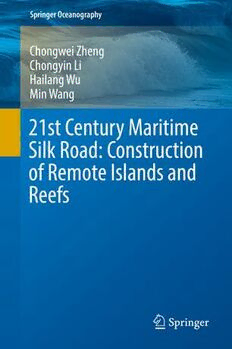
21st Century Maritime Silk Road: Construction of Remote Islands and Reefs PDF
Preview 21st Century Maritime Silk Road: Construction of Remote Islands and Reefs
Springer Oceanography Chongwei Zheng Chongyin Li Hailang Wu Min Wang 21st Century Maritime Silk Road: Construction of Remote Islands and Reefs Springer Oceanography The Springer Oceanography series seeks to publish a broad portfolio of scientific books, aiming atresearchers, students, andeveryone interested inmarinesciences. The series includes peer-reviewed monographs, edited volumes, textbooks, and conference proceedings. It covers the entire area of oceanography including, but not limited to, Coastal Sciences, Biological/Chemical/Geological/Physical Oceanography,Paleoceanography,andrelatedsubjects. Moreinformationaboutthisseriesathttp://www.springer.com/series/10175 (cid:129) (cid:129) (cid:129) Chongwei Zheng Chongyin Li Hailang Wu Min Wang 21st Century Maritime Silk Road: Construction of Remote Islands and Reefs ChongweiZheng ChongyinLi CollegeofMeteorologyand StateKeyLaboratoryofNumericalModeling Oceanography forAtmosphericSciencesandGeophysical NationalUniversityofDefense FluidDynamics(LASG),Instituteof Technology AtmosphericPhysics,Chinese Nanjing,China AcademyofSciences Beijing,China HailangWu No.91937ofPLA MinWang Zhoushan,China CollegeofMeteorologyandOceanography NationalUniversityofDefenseTechnolog Nanjing,China ISSN2365-7677 ISSN2365-7685 (electronic) SpringerOceanography ISBN978-981-10-8113-2 ISBN978-981-10-8114-9 (eBook) https://doi.org/10.1007/978-981-10-8114-9 LibraryofCongressControlNumber:2018948211 ©SpringerNatureSingaporePteLtd.2019 Thisworkissubjecttocopyright.AllrightsarereservedbythePublisher,whetherthewholeorpartofthe materialisconcerned,specificallytherightsoftranslation,reprinting,reuseofillustrations,recitation, broadcasting,reproductiononmicrofilmsorinanyotherphysicalway,andtransmissionorinformation storageandretrieval,electronicadaptation,computersoftware,orbysimilarordissimilarmethodology nowknownorhereafterdeveloped. Theuseofgeneraldescriptivenames,registerednames,trademarks,servicemarks,etc.inthispublication doesnotimply,evenintheabsenceofaspecificstatement,thatsuchnamesareexemptfromtherelevant protectivelawsandregulationsandthereforefreeforgeneraluse. The publisher, the authors, and the editorsare safeto assume that the adviceand informationin this bookarebelievedtobetrueandaccurateatthedateofpublication.Neitherthepublishernortheauthorsor theeditorsgiveawarranty,expressorimplied,withrespecttothematerialcontainedhereinorforany errorsoromissionsthatmayhavebeenmade.Thepublisherremainsneutralwithregardtojurisdictional claimsinpublishedmapsandinstitutionalaffiliations. ThisSpringerimprintispublishedbytheregisteredcompanySpringerNatureSingaporePteLtd. The registered company address is: 152 Beach Road, #21-01/04 Gateway East, Singapore 189721, Singapore Series Publications on the 21st-Century Maritime Silk Road (I) 21stCenturyMaritimeSilkRoad:APeacefulWayForward (II) 21stCenturyMaritimeSilkRoad:ConstructionofRemoteIslandsandReefs (III) 21stCenturyMaritimeSilkRoad:WaveEnergyResourceEvaluation (IV) 21stCenturyMaritimeSilkRoad:WindEnergyResourceEvaluation (V) 21stCenturyMaritimeSilkRoad:LocationChoiceofMarineNewEnergy (VI) 21stCenturyMaritimeSilkRoad:Long-TermTrendsofOceanicParameters (VII) 21stCenturyMaritimeSilkRoad:ThreatandCharacteristicsofSwell (VIII) 21stCenturyMaritimeSilkRoad:EarlyWarningofWaveDisasters v Preface TheBeltandRoadInitiative(SilkRoadEconomicBeltand21stCenturyMaritime Silk Road) highlights the continuationtheme, peace, and development ofChina.It brings an important opportunity to both the revival of the Chinese nation and the commonprosperityofthehumanbeing.Atpresent,comparingwiththesignificant progressthathasbeenmadeintheSilkRoadEconomicBelt,theconstructionofthe 21st Century Maritime Silk Road (shorten as “Maritime Silk Road” here after) is relativelylaggedbehind.TheMaritimeSilkRoadmainlyinvolvestheSouthChina Sea and the northern Indian Ocean. The South China Sea is well known as the secondPersianGulf.Meanwhile,theIndianOceanhasalwaysbeenregardedasthe worldseapowercenterandmarinelifeline.Itisnothardtofindtheimportanceofthe Maritime Silk Road. However, challenges and opportunities often coexist. The MaritimeSilkRoadhasalongroute,coversawidescopearea,andinvolvesmultiple nations. It confronted with lots of difficulties such as the complicated marine environment characteristics, weaknesses in infrastructures, difficulty in ocean replenishment, frequent trade friction, differences in the culture, instability of the politicalsituation,continuoussecurityconflicts,andsoon.Inaddition,thescarcity oftheoceandata,weakfundamentalresearch,andlackofsupportofthesystematic theorygreatlyincreasethedifficultyoftheconstructionoftheMaritimeSilkRoad. The marine key points that usually based on the important remote islands and reefs are the pivotal support for human society to step into the deep sea. Rational constructionofimportantremoteislandsandreefswillmakepositivecontributionto copewiththeabovedifficultiesthatconfrontedtheMaritimeSilkRoad.Aseriesof remote islands and reefs with stable and efficient function on the South China Sea andthenorthernIndianOceanwillcontributetoenhancethecapabilities ofocean- goingvoyage,integratedsupply,shipmaintenance,marineobservation,humanitar- ianassistance,medicalaid,etc.,thustomaketheMaritimeSilkRoadtobethemain artery of the international economy and energy. In this book, the necessity and difficultiesoftheconstructionofmarinekeypointsarefirstlypresented,suchasthe rationalselectionandriskevaluationofthekeypoint,urgentdemandofelectricity vii viii Preface andfreshwater,fragilityoftheecologicalenvironment,terriblesurvivalandmedical condition,complicacydisputeonmarinerightsandinterests,andthencorresponding countermeasuresareprovided. The remote islands and reefs are usually far from the mainland, which have a particularly urgent demand for electricity and freshwater resources. And this has seriouslyrestrictedmarinedevelopmentandutilizationactivitiesinthedeepseafora longtime.Intheeraofhighelectrification,mostequipmentscannotfunctionoreven beparalyzedwithoutelectricity.Humanbeingscannotsurvivewithoutfreshwater. The electricity on the remote islands and reefs usually relies on a diesel that is primarilyonshippingsupplies,andfreshwateralsodependsprimarilyonshipping supplies. Obtaining these supplies is especially challenging under bad sea condi- tions.Inaddition,theecosystemoftheremoteislandsandreefsisfragile.Thediesel powergenerationusuallyresultsinsignificantpollution.Oncetheecosystemofthe remoteislandsandreefsisdamaged,itisdifficulttorepair.Allthesedifficultieshave seriouslyrestrictedtheeconomicdevelopmentinthedeepsea.Rationalutilizingthe clean, renewable, nonpolluting marine new energy (wave energy, offshore wind energy, etc.) to develop wave power generation, offshore wind power generation, and seawater desalination according to local conditions will satisfy the electric energyrequirements,toprominentlyenhancethesurvivalandsustainablecapacities of the remote islands and reefs, thus to ensure the healthy development of the MaritimeSilkRoad.Thereisanobviousneedfor“resourceevaluationandplanning inadvance”inenergydevelopment.Duetothedatascarcityandtechnicaldifficul- ties,theresearchonthewaveenergyandoffshorewindenergyoftheSouthChina SeaandthenorthernIndianOceanisstillscarceuntilnow,especiallyonthemarine keypoints,whichisurgentlyneeded. The book focuses on coping with the electricity and freshwater shortage of the importantremoteislandsandreefs,thustoprovidetechnicalsupportforthemarine keypointsontheMaritimeSilkRoadtoovercometheenergydilemmas.According to the urgent demand of electricity and fresh water, a systematic evaluation on the windenergyandwaveenergyofaseriesofmarinekeypointsontheMaritimeSilk Road is carried out for the first time at home and abroad. And the Gwadar Port, remoteislandsandreefsoftheSouthChinaSea,etc.areselectedascasestudies.The wind and wave energy analysis systematically includes the value size of the wind/ wavepowerdensity,availablerateofenergy(effectivewindspeed occurrenceand effective wave height occurrence), richness of energy (energy level occurrence), coming direction of energy (co-occurrence of energy direction and power density, shorten as “wind/wave energy rose”), long-term trends of wind/wave energy resources, long-term prediction of energy, etc., thus to provide reference for the choice of power plants location, feasibility verification of wave power generation andwindpowergeneration,dailyoperation,andlong-termplanofwave/windpower generation. Several important marine key points of the Maritime Silk Road are selected as the case study (such as the Gwadar port, a remote island in the South ChinaSea),torealizetheelectricityandfreshwaterself-sufficiencyofthesemarine keypointsandthustoimprovetheirviability. Preface ix Understanding the marine environment characteristics is a prerequisite for the safe and efficient marine construction. For example, a storm surge in the Bay of Bengal in 1970 caused more than 300,000 deaths. A strong wave of about 6 m causedbythestormsurgein1991intheChittagongcausedabout140,000deaths. However,relativelyweakbasicresearchandscarcemarinedataseriouslyrestrictthe analysisofmarinecharacteristicoftheremoteislandsandreefsoftheMaritimeSilk Road and urgently need to be addressed. To promote the safe and efficient imple- mentation of the remote islands and reefs construction, disaster prevention and reduction, prolong the life of the electric generator, and so on, we also analyzed the marine environment of the marine key points on the Maritime Silk Road, systematically including the monthly variation of wind speed and significant wave height,windclassoccurrence,waveclassoccurrence,characteristicsofstrongwind (co-occurrence of wind speed and wind direction), characteristics of strong wave (co-occurrenceofsignificantwaveheightandwavedirection),extremewindspeed andextremewaveheightwithdifferentreturnperiods,andlong-termtrendofwind speedandwaveheight.Inaddition,therunwayisoneofthemostimportantpartsof theremoteislandsandreefsconstruction.Weselectaremoteislandastheassumed object of study to statistically analyze the wind climate characteristics under the demand of runway design, mainly including the wind rose (co-occurrence of wind direction and wind speed), gale occurrence, occurrence of gust wind speed above 10.8 m/s, gust index, and so on, to provide scientific reference for the decision- makingofrunwaydesignofremoteislandsandreefs. The evaluation and utilizationofwind/wave energy resources will make contri- bution to realize the electricity and freshwater self-sufficiency of the important remoteislands and reefs; theanalysisofmarine environment isbenefitfor thesafe and efficient construction of the important remote islands and reefs. We hope the method and scheme formed in this book can be popularized in the construction of remote islands and reefs in global oceans, especially the Maritime Silk Road, to enhancethecapabilityofmarinedevelopmentandutilization. Nanjing,China ChongweiZheng Beijing,China ChongyinLi Zhoushan,China HailangWu Nanjing,China MinWang Acknowledgments This work was supported by the Open Research Fund of State Key Laboratory of Estuarine and Coastal Research (Grant No. SKLEC-KF201707), the National Nat- uralScienceFoundationofChina(No.41490642,No.41775165),theKeyLabora- tory of RenewableEnergy, and Chinese Academy of Sciences (No.Y707k31001). All the authors would like to thank ECMWF for providing the ERA-Interim wind andwavedataandERA-40wavereanalysisandthankthePO.DAACforproviding thecross-calibrated,multi-platform(CCMP)winddata. xi
